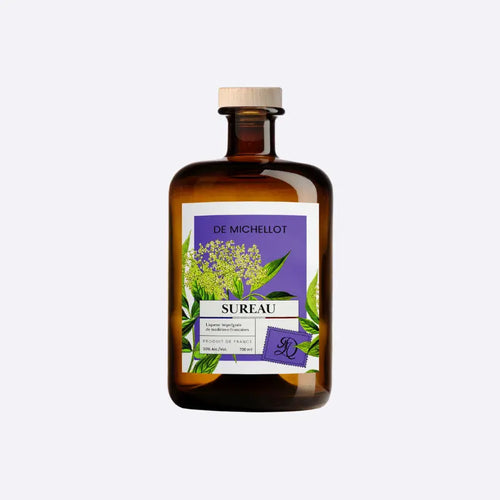Introduction
A symbol of French refinement and monastic know-how, Bénédictine is a world-famous herbal and spice liqueur .
Known for its rich aroma and aromatic complexity, it combines tradition, mystery and elegance.
But behind this prestigious name lies a fascinating story - that of an elixir inspired by the Benedictine monks of Fécamp and passed down through the centuries.
Let’s discover together its origin, its recipe, its taste, and the French artisanal alternatives like Michellot Plant Liqueurs .
The origin of Benedictine
Benedictine has its roots in the 16th century, in the monastery of Saint-Benoît in Fécamp , in Normandy.
A herbalist monk, Dom Bernardo Vincelli , is said to have developed a health elixir made from 27 plants and spices.
Lost during the Revolution, the recipe was rediscovered in the 19th century by a wine merchant, Alexander the Great , who relaunched production in 1863 under the name “Bénédictine” .
🍸 Bénédictine is now distilled and aged in the Palais Bénédictine in Fécamp, which has become an emblematic place of French spirits heritage.
The secret composition of Benedictine
The exact recipe for Benedictine is kept secret, but it is known to combine 27 plants and spices from around the world .
Main plants and spices
-
🌿 Lemon balm
-
🍋 Lemongrass
-
🌱 Angelique
-
🌾 Hyssop
-
🌸 Clove and cinnamon
-
🌰 Nutmeg
-
🍯 Honey and saffron
These ingredients are macerated in neutral alcohol, distilled, then blended with sugar and honey to create a sweet, spicy, and floral liqueur .
🌼 Each bottle is the result of meticulous work: macerations, distillations, blends and aging in oak barrels.
The unique taste of Benedictine
The Benedictine seduces with its roundness and aromatic complexity .
It is a liqueur that is at once sweet, herbaceous, lemony and spicy , which evolves elegantly in the mouth.
Taste profile
-
🌿 Notes of medicinal plants and warm spices.
-
🍯 Sweet sweetness balanced by a slight bitterness.
-
🌸 Long, vanilla and honeyed finish.
A liqueur that is both an aperitif and a digestive, a symbol of French know-how for over a century.
The variations and uses of Benedictine
As an aperitif or digestif
Served chilled or neat , Benedictine expresses all its floral and sweet nuances.
In a cocktail
Highly prized by bartenders, Bénédictine brings a complex and spicy touch to classic cocktails.
Some famous recipes:
-
B&B (Benedictine & Brandy) : 3 cl of Benedictine + 3 cl of cognac.
-
Singapore Sling : gin, cherry, lemon, Benedictine and soda.
-
Monte Carlo : rye whiskey, Benedictine and bitters.
In the kitchen
It also flavors desserts and sauces, particularly those made with citrus fruits, chocolate or candied fruit.
Benedictine and French herbal liqueurs
Benedictine belongs to the large family of French herbal liqueurs , just like Chartreuse , Verbena du Velay or Gentiane .
They all come from the same heritage: the transformation of medicinal plants into digestive and aromatic spirits .
🌿 Today, artisanal houses like De Michellot perpetuate this tradition through natural, balanced liqueurs that respect the terroir.
Artisanal alternatives to Benedictine
La Bénédictine is an icon, but its sweet and spicy profile is inspiring a new generation of French artisanal producers .
Les Liqueurs De Michellot are part of this line, with natural recipes, less sweet and more plant-based :
-
Gentiane De Michellot → floral and fresh bitterness.
-
Verbena De Michellot → lemony and digestive freshness.
-
Génépi De Michellot → floral and mountain sweetness.
-
Michellot Mint → distilled and refreshing.
🌼 French artisanal creations, made from natural plants, which pay homage to the spirit of the Benedictine.
A liqueur that stands the test of time
More than a century after its creation, the Bénédictine remains a symbol of elegance and French tradition .
His expertise still inspires distillers, bartenders and lovers of rare spirits today.
🍸 At De Michellot , this heritage translates into a common desire: to preserve the naturalness of herbs and enhance artisanal French liqueurs .
Conclusion
Bénédictine is much more than a liqueur: it is a part of French history , a bridge between botany, religion and gastronomy.
And to extend this floral and spirituous experience, discover Michellot's Plant Liqueurs — a modern and artisanal collection, inspired by the greatest French traditions.
Benedictine, Benedictine liqueur, Benedictine liqueur, French liqueur, herbal liqueur, Benedictine cocktail, Benedictine composition, French digestif, Benedictine alternative, herbal liqueur
